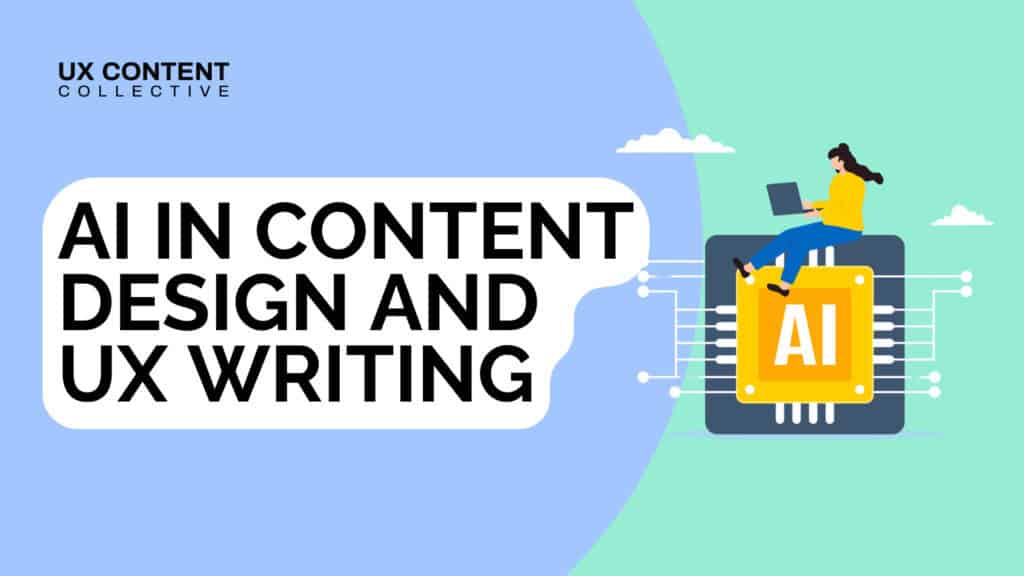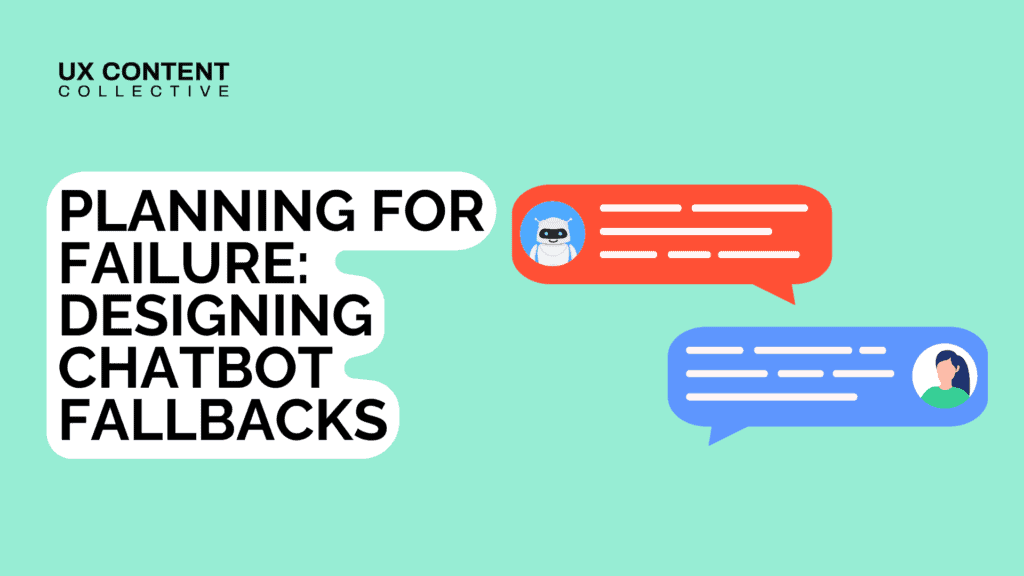
How AI is changing UX writing and content design

Patrick Stafford

Interested in AI and conversation design?
Explore our conversation design and AI training:

Content designers have found themselves at the center of changes caused by artificial intelligence. Whether it’s using tools in day-to-day writing, helping create dynamic systems, or helping train and evaluate the models themselves, content design has proven invaluable.
Right now, content design isn’t so much being redefined as it is expanded. In a world where machines can write, but not reason, contextualize or empathize, content designers play a key role.
This is exactly why companies like OpenAI and Anthropic have hired content designers. These tools, and others like them including Google Gemini, have led to an explosion in AI-generated content. But creating helpful, clear, and context-sensitive UX content still depends on human judgment. As AI becomes embedded in the tools we use and the interfaces we design for, content designers are taking on new roles – shaping how content is produced, evaluated, and governed at scale.
We outlined the early shifts that started unfolding when generative AI models entered the mainstream. Since then, we’ve seen a rapid acceleration: companies are hiring for AI content roles, designers are integrating LLMs into their workflows, and content professionals are being asked to define prompt layers, evaluate model output, and structure training data.
If you’re a UX writer or content designer wondering where you fit into all this, the answer is simple: you’re essential. Your skills are already part of the AI pipeline – you just might not know it yet.
And if you’re new to the profession, then there’s good news. AI is expanding the types of roles and responsiblities that UX writers and content designers take on.
- Want to know more? Read how content designers should approach AI-first design.
Content designers as AI model contributors
Content designers are beginning to work with AI in a few different ways:
- In day-to-day UX writing work, using tools like ChatGPT, Claude, or Gemini to brainstorm or modulate strings with different tones
- As a key focus for model designers, as they create example content and help craft system messages that are powering features and products driven by Large Language Models
- As the basis quality assurance, as content designers evaluate model output on a qualitative basis for language, user intent, and other UX metrics
Content designers are moving upstream in the model development process. They’re helping define what good output looks like. They’re shaping the inputs that drive LLM behavior. A growing number are partnering directly with AI teams to structure training data and system prompts.
This shift is critical, because language models are only as good as the data and instructions they’re given. Without strong editorial standards, clear logic, and meaningful user context, the output from generative models can be inconsistent, biased, or confusing. That’s where content design makes the difference.
In fact, as we explain in How to Create a Custom GPT for Content Design, building a truly useful AI assistant requires far more than writing prompts. It involves setting guardrails, defining tone, and structuring data in a way that reflects real-world user needs. These are all content design tasks, and they’re helping content designers expand their scale and impact by helping designers check if their content meets an organization’s standards.
We’re also seeing content designers contribute to model evaluation especially in areas like tone consistency, clarity, and usefulness. This means identifying the dimensions that matter (e.g. accuracy, voice, safety), then testing model behavior against those dimensions using both qualitative and quantitative methods.
In this expanded role, content designers help craft interface text, but they go beyond that and help shape the logic, structure, and standards that power AI-driven products.
How AI changes the design process for writers
When large language models (LLMs) become part of the interface, or the engine behind it, content becomes a core system layer. And content designers need to think like system designers.
That starts with prompt engineering. Whether you’re working on a chatbot, a generative onboarding flow, or a smart help system, you need to design the instructions that guide model behavior. This means writing system messages: background instructions that shape how the model responds, and experimenting with prompt structures to achieve specific tone, accuracy, or length goals.
Writers are also responsible for evaluating and refining model outputs, ensuring that generated content meets product standards. This often includes:
-
Applying editorial judgment to AI responses
-
Conducting quality checks for hallucinations or inappropriate content
-
Editing and rewriting for voice, accessibility, and structure
While some of these tasks can be conducted by models themselves with quantitative evaluation benchmarks, it’s best to combine automated checks with human QA. And while these tasks might feel similar to traditional UX writing, the context is new. Instead of polishing a single button label or confirmation message, content designers now evaluate thousands of AI-generated strings as a sample set. This requires a structured approach, a defined set of success metrics, and a shift in mindset: from one-off microcopy to language systems design.
AI elevates content design into a new kind of systems-thinking role. One where writing, logic, testing, and governance all come together to shape product behavior at scale.
- Read more: how should AI be used in the content design process?
- How AI is transforming the UX writing process
- Should we use GPT in the UX writing process?
Emerging AI roles in content design and UX writing
Companies are looking for people who understand both language and logic – people who can bridge the gap between natural language and technical systems. That’s where content designers come in.
Some roles focus on prompt and system message design – crafting instructions that guide how a model responds within a product experience. Others focus on evaluation and QA, applying defined frameworks to assess whether AI-generated output meets user needs and business goals. Still others work across disciplines, supporting machine learning and product teams with training data, feedback loops, and logic frameworks that support scalable, user-centered content.
In our podcast episode AI and UX Writing, we explored how these roles are developing in real organizations. Content designers are sitting in model evaluation meetings, helping shape output guidelines, and working with engineers to establish what “good” language looks like when it’s being generated dynamically.
Ethics, accuracy, and judgment
As AI-generated language shows up in more products, it introduces a set of risks. Accuracy, tone, context, and ethical decision-making have always been an important part of content design, but especially so now.
When writing for user interfaces, content designers need to ensure that any AI-driven features are explained thoroughly, clearly, and that any material used to power those features has been checked and assessed.
The more users have transparency and agency over their interactions with AI, the more likely they’ll trust the user experience. This is more of the traditional role UX writing and content design has taken in focusing on user interface content, and it’s one of the most important in working with generative AI.
AI can produce polished language that sounds confident but includes errors, bias, or misinformation. It can reinforce stereotypes, misrepresent product capabilities, or deliver instructions that mislead users. And because AI output is often probabilistic, the same prompt can produce slightly different results each time making consistency hard to guarantee.
Content designers are uniquely positioned to bring editorial oversight to AI outputs. That includes:
-
Defining and enforcing voice and tone guidelines for generated content
-
Identifying and removing biased or inappropriate language
-
Flagging outputs that break UX patterns or introduce confusion
-
Creating fallback content and error states when models fail or behave unpredictably
- Creating user interface text that sets expectations and trains users on risk and reward
Judgment also plays a role in where AI should and shouldn’t be used. Just because something can be generated doesn’t mean it should be. Writers often need to ask critical questions:
-
Is this moment high-risk or sensitive?
-
Could dynamic content create legal or trust issues?
-
Will generative language create more confusion than clarity?
The best AI-integrated products are the ones where humans set the standards and models follow. Content designers are already playing this role in many teams, acting as editors, ethicists, and decision-makers behind the interface.
Examples of AI use in content design work
The idea of using AI in content design can feel abstract until you see how it plays out in real product teams. Across industries, content designers are using AI not as a replacement for their work, but as a tool to accelerate decision-making, scale quality, and expand what’s possible.
Based on our content design industry survey and discussions with industry experts, here are a few of the most common and effective use cases we’re seeing:
Variant testing and message exploration
Writers are using generative models to draft multiple versions of UX messages like onboarding copy, empty states, or notifications and quickly test them against tone, clarity, and intent. In our article 4 Ways to Use Generative AI in UX Writing, we walk through methods for generating alternatives and running lightweight evaluations to see which ones resonate most.
Some content designers are also building out internal tools to help test content against guidelines, allowing them to scale their output and help others in design teams create content that remains consistent. In this way, AI becomes a helpful scaling tool.
Help content and microcopy drafting
Some teams are using AI to generate first drafts of contextual help or support content especially in tooltips, help modals, or chatbot interfaces. While final editing still relies on human review, AI can reduce the time it takes to move from idea to usable copy.
Localization-friendly drafting
AI is particularly useful when content needs to be written with translation in mind. Writers are using prompts to generate messages that avoid idioms, wordplay, or culturally complex phrasing, making localization smoother downstream.
There is still human review required here, of course. But AI does enable projects to get started faster than they would have otherwise.
Prompt template creation
In AI-powered products (like chat interfaces or adaptive assistants), content designers are building prompt templates that can be reused across user types or scenarios. This reduces the need to reinvent complex instructions and helps maintain consistency across outputs.
Content evaluation at scale
When hundreds or thousands of strings are being generated, content designers are creating rubrics and model evaluation workflows to assess quality, tone, and alignment. These outputs are often paired with traditional UX research methods to validate effectiveness.
In all of these cases, AI doesn’t remove the need for good writing. It expands the scope of what content designers can influence – and gives them more tools to shape the systems they’re part of.
Careers in focus: AI writer jobs for content designers
More content design job descriptions are asking for experience or at least a willingness to work with Large Language Models. For many of these jobs, the skills required are the ones we’ve already mentioned: the ability to discern good writing from bad, prompt engineering, the ability to evaluate output, and to work as part of a design team.
If you’re a UX writer or content designer today, you may already have the foundational skills required for an AI writer job:
-
Clear, purpose-driven writing
-
Familiarity with structured content and logic flows
-
A strong editorial lens for tone, clarity, and inclusivity
-
The ability to evaluate language not just for grammar, but for behavior and intent
AI writer roles vary across companies, but many involve:
-
Designing prompt templates and system messages
-
Evaluating model-generated content at scale
-
Collaborating with product and ML teams to shape output guidelines
-
Testing copy for edge cases, safety, and tone alignment
What skills content designers need to thrive with AI
Content designers who want to thrive in AI-integrated teams don’t need to become machine learning experts. But they do need to develop a new layer of technical and strategic fluency.
Here are the core skills that matter most:
Prompt and system message design
Writing for AI begins with writing to AI. Content designers are learning how to structure prompts that drive consistent, on-brand responses. That includes crafting system messages for tools custom models, designing reusable input templates, and adjusting instructions based on tone, voice, or user type. As we outline in How to Create a Custom GPT for Content Design, prompt design is both an editorial and strategic task.
Evaluation and output testing
AI-generated copy needs the same scrutiny as any other UX content, just at greater scale. Content designers are building evaluation frameworks that include criteria like clarity, inclusiveness, tone match, and factual accuracy. These frameworks help them work with researchers and product teams to assess whether AI outputs support both user goals and business objectives.
Structured content and metadata awareness
To work effectively with LLMs, writers need to understand how content is stored, categorized, and reused. Structured content skills like modular writing, token usage, and schema-based logic enable designers to create flexible, scalable content systems that AI can plug into.
Systems thinking
Designing AI-assisted content requires thinking beyond screens. Writers need to consider how prompts, user context, fallback responses, and escalation paths all connect. That means understanding how content flows through different parts of the product not just as copy, but as logic and interaction. This mindset is core to working in dynamic systems.
Editorial judgment and ethical foresight
The more AI is involved, the more essential it becomes to apply human values to automated output. Writers need to be able to spot bias, flag inappropriate phrasing, and define tone boundaries that support brand trust. This isn’t new, but the speed and scale of AI-generated content makes editorial judgment more important than ever.
As new tools emerge and teams evolve, the skill set for content designers will keep growing. But the foundation remains the same: clear thinking, clear communication, and a strong sense of what good content looks like in the real world.
Final thoughts on AI in UX writing and content design
Whether you’re shaping prompts, evaluating model outputs, or structuring reusable content, the role of the content designers is expanding. You don’t need to be an engineer, but you do need to think systemically, apply editorial standards to new contexts, and advocate for clarity and responsibility in increasingly complex workflows.
AI may generate the words – but content designers give them meaning.
Frequently Asked Questions
What is the role of a content designer in AI?
Content designers working with AI help shape prompts, system messages, model evaluation criteria, and content structure to ensure generative outputs are useful, clear, and appropriate.
Can UX writers work in AI?
Yes. UX writers are contributing to prompt design, training data refinement, AI content review, and output testing—often becoming integral parts of AI product teams.
What is an AI content writer?
An AI content writer is someone who creates, refines, and evaluates content produced by or for AI systems. In UX, this often means curating microcopy, help content, and user-facing responses from LLMs. The typical title, however, is still “Content Designer”.
What skills do content designers need for working with AI?
Key skills include prompt design, structured content modeling, content evaluation frameworks, system thinking, and editorial judgment especially around ethics and tone.
Is AI replacing UX writers or content designers?
No. AI is changing the way content work happens, but human oversight remains critical. Content designers are increasingly leading the design of systems that include AI.



